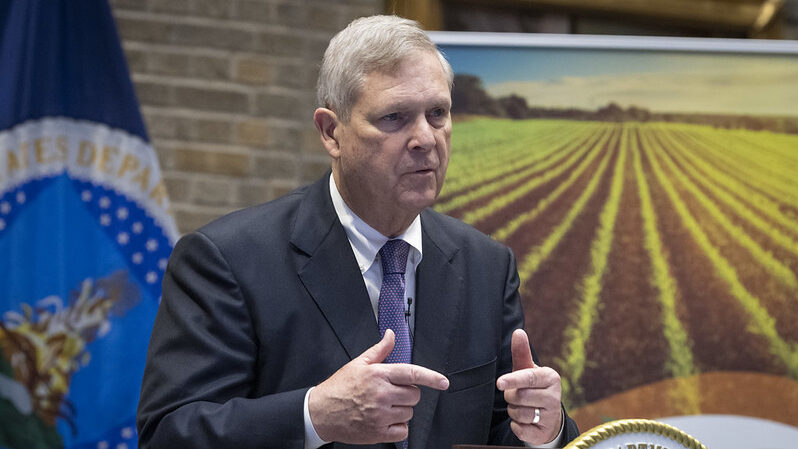
Insight & Opinion
U.S. farmers are at the sharp end of climate change, writes U.S. Secretary of Agriculture Tom Vilsack, but they are adapting and rising to the challenge. Their climate smart practices are already making a difference. And USDA programs and investments will help advance their efforts, empowering American agriculture to meet consumer demand, protect the environment, and tap into new market opportunities.
There is no question that agricultural producers, rural communities and consumers are experiencing the impacts of a warming climate first hand, perhaps more than most. An intensifying and growing wildfire season, more powerful storms, and longer and more intense droughts all threaten the property, livelihood and wellbeing of rural communities and agriculture producers. For producers, these challenges also threaten their businesses, potentially causing yields to fall, costs to rise and increased prices for consumers.
The good news is that American agriculture is and will continue to help lead the way for the rest of the world in tackling this crisis. U.S. farmers are already adapting to climate change and reducing the greenhouse gas emissions that cause it.
Technologies such as precision agriculture allow farmers to apply inputs more efficiently, reducing environmental impacts of overapplication of nutrients. Enhanced efficiency fertilizers are reducing emissions from nitrous oxide – the largest source of greenhouse gas emissions in the U.S. agriculture sector. From the most recent USDA data available, the number of cropland acres where these improved fertilizers are applied increased more than 6-fold between two surveys conducted from 2003-2006 and 2013-2016. Another tool, cover crops, which increase soil carbon by sequestering excess carbon from the atmosphere, saw adoption increase by 50 percent between 2012 and 2017. This trend continues as cover crop adoption on corn-for-grain fields increased by 44 percent between 2016 and 2021.
At U.S. Department of Agriculture (USDA), we have a launched a comprehensive strategy to advance climate-smart agricultural practices like these through solutions that are led by producers, flexible, and grown from the bottom-up. If our policies don’t work for our farmers, ranchers, and rural communities, then they won’t work for the climate.
Our strategy includes increasing financing in our current Farm Bill conservation and energy programs to provide opportunities for farmers to adopt climate smart practices and increase investments in science, research and innovation, all while embracing a bright and positive future for renewable fuels and renewable energy.
Our work is centered around the idea that many of the same agricultural practices that make agricultural operations more resilient in the face of climate change can also help tackle the problem itself, all while creating new sources of revenue for producers.
This year, we launched a key component of our strategy called Partnerships for Climate-Smart Commodities.
Consumers at home and abroad increasingly want to know where their food comes from and how it is produced. Through their purchasing power, consumers want to help the environment, not hurt it. At USDA, we want to help farmers tap into that demand and take advantage of these new market opportunities.
Through Partnerships for Climate-Smart Commodities, we are investing $1 billion to finance the production of climate-smart products and expand these markets. We envision that groups of multiple producers, companies, NGOs, and other important stakeholders will come together to apply climate smart production practices on farms, ranches and forest lands and foster new markets for the commodities they produce.
This partnership effort has a particular emphasis on clearly measuring the climate progress we’re making through the application of these new production practices, and on involving all segments of American agriculture – both big and small operations, conventional and organic, row crops and specialty crops, historically underserved producers, forest landowners, urban farmers, and others.
The first round of proposals attracted a tremendous interest from a diverse cross-section of groups from across the country. We received over 450 large-scale proposals, ranging from $5 million to $100 million each, covering a geographic scope of every state in the nation, tribal lands, D.C., and Puerto Rico. In all, we received over $18 billion in collective application interest for the first round of funding under this program.
Already, the enormous demand for Partnerships for Climate-Smart Commodities is shining a bright light on the appetite of the full diversity of American agriculture to create climate smart commodities that hold higher value in the marketplace.
Climate change is one of multiple urgent challenges facing farmers today, and the game is changing. Farming is no longer just about what food is produced. It’s about how that food is produced.
Challenges also present opportunities.
American producers have shown again and again that they are able to tackle challenges with creativity, ingenuity, and innovation, reminding us that we should approach obstacles with the optimism that we can rise to meet them.
It is through our approach at USDA we are further empowering American agriculture to produce the goods that consumers want and that are better for the environment, all while ensuring that we are among the first in the world to capture the market for climate smart agriculture.
We are well on the way to making sure that American farmers, ranchers, and forest landowners continue to rise to challenges—including tackling the existential crisis of climate change.


